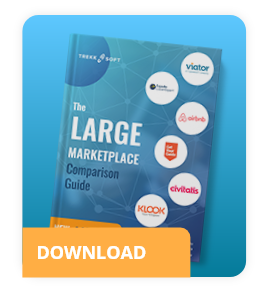This article was originally written in 2019 and his updated in 2021 for relevance.
In 2019, we saw the exponential increase in OTAs market share in tours and activities, where operators were losing control over how they distributed their products.
In an article written by our former CEO, Olan O'Sullivan, he pointed out that "Capital is flooding into distributors who are fighting it out for consumer eyeballs and this is a high stakes game with plenty of subtexts."
We spoke in detail about the pattern of OTAs entering the tourism sector, increasing market-share and in-turn increasing commissions. Below, you can view the evolution of OTAs from airlines, hotels and now tours & activities.

Source: TrekkSoft
To combat OTA market-share growth and to be in control of their distribution, airlines and hotels turned to revenue management.
"We have a lot to learn from the wider travel industry. Don’t get distracted by all the noise around reservation systems. The real battleground is where your products are sold."
In this post, we will introduce you to revenue management and how you can implement these strategies in your tour or activity business.
What is revenue management in hospitality and hotels?
Revenue Management began in the 1980’s across the Airline Industry. To optimise financial results, airlines began to use ‘Dynamic Pricing’ where they would set seat prices based on anticipated consumer demand.
Broadly speaking, Revenue Management is the use of analytical data, which can help to predict the behaviour of customers, so that product availability and price can be optimised in order to generate the maximum amount of revenue possible.
In hotels, revenue management is a commonly used practise to sell smart. With the right execution, you will sell the right products to the right person for the right price at the right time through the right channels with the best commission efficiency. Yield management is just a small part of Revenue Management.
Revenue management simplified

Source: TrekkSoft
This is a simplified example as most hotels with have multiple room types and various demand days/periods.
Revenue management works well for hotels as they have:
- Fixed capacity
- Perishable product
- High fixed costs and low variable costs
- Product can be priced differently
- Demand evolves
- Product can be sold in advance
- Market can be segmented
Revenue Management Strategies Employed

Source: TrekkSoft
Market Segmentation - Understanding your market to see where demand comes from. What types of consumers do you have? What are their buying patterns, needs and expectations.
Pricing Structure - Optimise your pricing based on each particular segment. This could include corporate rates, wholesale rates or packages.
Seasonality and Events - Identify your shoulder months and high seasons, look at peak days of the week, and any upcoming ‘key’ dates or events.
Distribution Network - Selecting the right channels which reach each market segment including direct, OTAs, partners, resellers and advertisement.
Historical Data and Booking Patterns - Look at your analytics to identify booking patterns, trends and pace.
Market Overview - Look at your city tourism, economy, competitor volume/rates, and industry news.
Optimise Commissions - Chose the channels that maximise sales with the least commissions.
Forecasting Strategies - Anticipate future demand and revenue, enabling necessary adjustments to be made.
Dynamic Pricing - Room rate pricing based on demand. Lower rate rooms in shoulder months, higher pricing when higher demand is expected.
Direct Booking Incentives - Discounts, best rates or add ons made available for those customers who book direct. Another example is Loyalty Schemes.
Distribution Based on Demand - Using offers with Online Travel Agents, allocating to membership/loyalty schemes, tour bookings, corporate rates etc...
Last Minute Offers - Higher rates if there is walk-in demand, lower rates with a promotion if there are a number of rooms available and to sell is better than to have empty rooms.
Learn all about revenue management strategies that you can use in your tour business
Header image from https://unsplash.com/photos/ZSPBhokqDMc.




